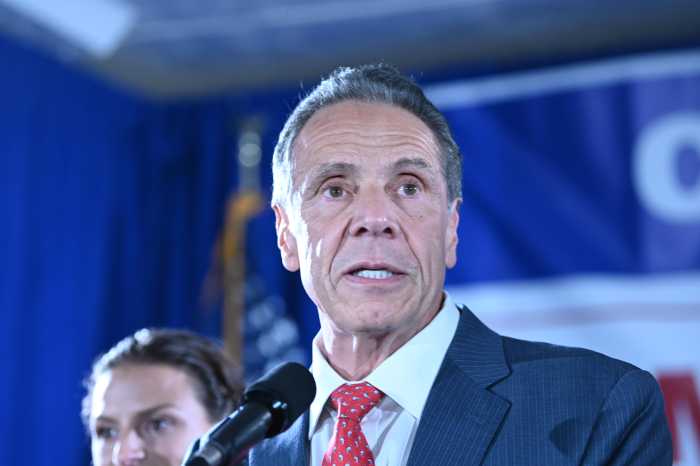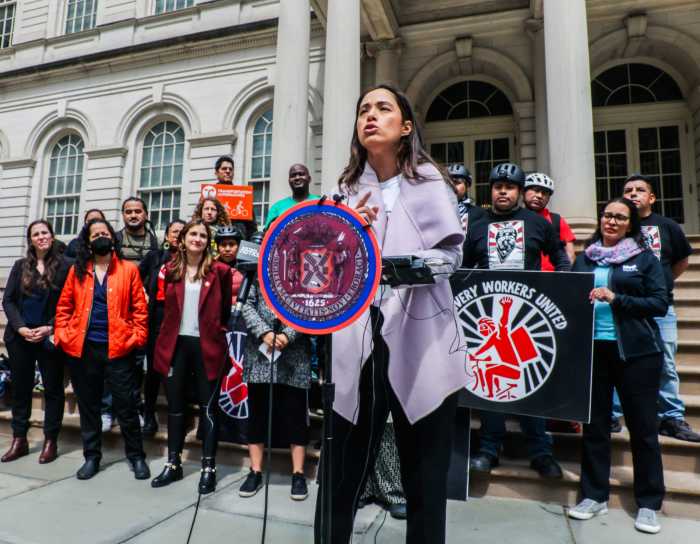President Donald Trump’s decision to eliminate the Deferred Action for Childhood Arrivals program on Tuesday has left hundreds of thousands of young immigrants living in the country illegally unsure of their futures.
Attorney General Jeff Sessions announced that the administration was doing away with the Obama-era program that protected nearly 800,000 so-called “Dreamers” – 42,000 of whom reside in New York State – from deportation on a two-year, renewable basis.
Trump’s decision drew immediate condemnation from immigration advocates, politicians and celebrities. Some 200 people, including DACA enrollees and their supporters, protested outside Trump Tower in Manhattan on Tuesday.
“We don’t know what’s next for our future,” Brazil native Thais Marquez, 23, said outside the president’s namesake tower.
Rather than eliminating the program outright, which would have left DACA recipients immediately vulnerable to deportation, the Trump administration chose to wind down the program over the course of six months. Congress has until March 5 to come up with a legislative alternative to the program, Sessions said.
While the termination of DACA has created a sense of uncertainty and outrage among those enrolled, the move “doesn’t change anything” for current Dreamers at the moment, explained Hasan Shafiqullah, attorney-in-charge for the Legal Aid Society’s Immigration Law Unit.
The structure of the phaseout means that hundreds of thousands of DACA recipients will continue to be able to work in the United States legally through 2019.
Immigrants who have current DACA status can remain on the program until their two-year work permits expire. Those whose work permits expire before March 5, 2018, can apply to renew those permits for another two years, but they must apply to do so before Oct. 5. Any renewal requests filed after that date will be denied.
Former DACA enrollees whose work permits expire will be considered to be in the United States without permission and are eligible for removal, but they will be a low priority for immigration enforcement, administration officials said.
Nearly 202,000 DACA recipients’ work permits have expired or will expire between August and December, and more than 275,000 will expire in 2018, according to Department of Homeland Security officials. The administration did not immediately have figures on how many DACA recipients will see their work authorizations expire between now and March.
“But if you’ve never had DACA, they won’t accept any new filings,” Shafiqullah said, adding that initial and renewal applications filed before Sept. 5 would be granted on a “case-by-case basis.”
Nearly 35,000 new DACA applications and close to 72,000 renewal requests were pending with the U.S. Citizenship and Immigration Services, as of Aug. 20.
Trump’s decision, however, does change DACA recipients’ permission to travel, which could affect their ability to become citizens in the future, Shafiqullah said.
“Travel has been a huge benefit for DACA recipients,” he said.
The Trump administration is no longer accepting applications from DACA beneficiates for advance parole, which is a type of permit that enables a person who entered the U.S. illegally to leave and re-enter the country after traveling abroad.
“If you had one pending, they’re not going to adjudicate them,” Shafiqullah added. Instead, the government will administratively close those applications and send back the $575 application fee.
DACA enrollees with certain close family members living in the United States and who re-enter the country on advance parole could set themselves up for a green card.
“The fact of traveling itself doesn’t give you any rights,” explained Shafiqullah. “It sort of fixes that they came [into the U.S.] the first time without permission.
“It opens the door for getting a green card through certain close family members,” he added. That door is now closed for DACA recipients.
The hope now, Shafiqullah said, is that Congress will pass the DREAM Act or some version of it before the March 5, 2018, deadline.
“That would be the best outcome,” he said.
The DREAM Act would provide a path to citizenship by offering qualified recipients an opportunity to secure a green card. Green card holders can apply for citizenship after five years of living in the United States.
“It’s unclear whether it can pass now. But it’s been reintroduced with bipartisan support,” Shafiqullah said.
Another option for conservative lawmakers, is the Bridge Act, which Shafiqullah described as “DREAM Act light.”
The Bridge Act is specifically aimed at DACA recipients, and would provide a work permit and protection from deportation to those who qualify.
“The Bridge Act is really just a longer version of DACA – but it’s more palatable to conservatives,” Shafiqullah said.
The biggest difference between the Bridge Act and DACA is that the latter was created by former President Barack Obama through executive order, a move that many Republicans see as an overreach of executive power.
Some lawmakers, including Sen. Kirsten Gillibrand (D-NY), have already begun to rally behind the DREAM Act.
“President Trump’s action today is an affront to who we are as Americans. He is needlessly targeting children who know no other country as home than America,” Gillibrand said in an emailed statement. “Congress must lead where the president won’t and pass the DREAM Act.”
Ahead of Tuesday’s announcement, Trump tweeted that Congress should get ready to do its job when it comes to DACA. He later said he wants Congress to find a legislative solution for Dreamers.
“I have a great heart for the folks we’re talking about, a great love for them,” Trump told reporters Tuesday afternoon. “I can tell you in speaking to members of Congress they want to be able to do something and do it right and really we have no choice.”
With Reuters






































